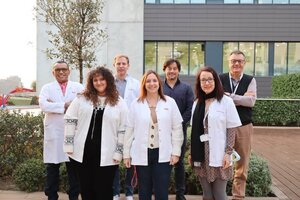Mitochondria-lysosome contacts: a new cell phenotype in neurogenetic diseases
The Neurogenetics and Molecular Medicine research group of the Institut de Recerca Sant Joan de Déu (IRSJD), in collaboration with the Neuromuscular Pathology Unit of the SJD Barcelona Children's Hospital (HSJD), has studied the pathophysiology of mitochondrial dynamics and mitochondrial- lysosome contacts in cells from patients with neurogenetic diseases. The article has been published in the journal Frontiers in Neuroscience.
Mitochondria are the organelles responsible for producing cellular energy. In addition, they are involved in other functions such as the metabolic state of the cell, programmed cell death, calcium homeostasis, and the generation and control of reactive oxygen species. They are very dynamic structures, which change their shape and spatial distribution according to the metabolic requirements of the cells at any given time. This changing nature is known as mitochondrial dynamics, which allows the regulation of mitochondrial architecture and the movement of mitochondria through the cytoskeleton.
Several studies indicate that mutations in genes related to mitochondrial dynamics cause various neurogenetic diseases. To better understand the consequences that these mutations can have, researchers have compared the phenotypes of the fibroblasts (cells found in the connective tissue) of two groups of patients. The first group is patients carrying pathogenic variants in genes involved in mitochondrial dynamics such as DRP1, GDAP1, OPA1 and MFN2. The second group corresponds to patients carrying mutations in genes that affect the mitochondrial phenotype indirectly, such as FXN, MED13 and CHKB.
Researchers find new cellular phenotypes of diseases associated with mitochondrial dynamics
Researchers have identified alterations in the morphology of the mitochondrial network and of the lysosomes in these patients. In addition, they have discovered a new protein pair between the mitochondria-lysosome contacts, formed by LAMP-1 and MFN2, which opens new horizons in the understanding of the pathophysiology of these diseases.
"The study of mitochondrial dynamics and the mitochondrial-lysosome axis in a group of patients with different neurogenetic diseases has allowed us to decipher cellular phenotypes that provide new insights into mitochondrial pathophysiology, as well as new biomarkers and pharmacological targets of these diseases" comment Dr. Jordi Pijuan and Dr. Lara Cantarero, first authors of the paper and researchers from the Neurogenetics and Molecular Medicine group of the IRSJD.
Most of the genes that confer these phenotypes are related to the structure of the mitochondrial membrane or its lipid composition. Specifically, the GDAP1 and MFN2 genes are related to a group of genetic neuropathies known as Charcot-Marie Tooth (CMT), which affect approximately 1 in 2,500 people. Patients with CMT present involvement of the peripheral nerves involved in the transmission of motor and sensory signals.
"This knowledge can facilitate personalized treatment of patients with neurogenetic diseases or even the selection of patients for clinical trials with a specific cellular profile" conclude Drs. Francesc Palau and Andrés Nascimento, heads of the Neurogenetics and Molecular Medicine group and the Neuromuscular Pathology Unit, respectively.
Translational research, key to advancing in the clinic
Better understanding of the pathophysiology of neurogenetic diseases is increasingly necessary for the clinical setting, with the aim of identifying new biomarkers and pharmacological targets to diagnose and ultimately treat patients.
For this reason, translational research is key since it is basic scientific research oriented towards clinical application. This is one of the objectives of the Neurogenetics and Molecular Medicine group, led by Dr. Francesc Palau and Dr. Janet Hoenicka, which investigates rare neurogenetic diseases that affect the development and functioning of the central and peripheral nervous systems. They study genetics and genomics in patients and use experimental biology as a tool to study pathophysiology and therapeutics in different cell and animal models.
"The results of this study show the importance of translational research with fibroblasts from patients with neurogenetic diseases, since they are cells that allow us to understand the pathophysiology and altered biological processes of clinical interest" comments Dr. Janet Hoenicka, head of the group of Neurogenetics and Molecular Medicine.
Paper reference
Pijuan Jordi, Cantarero Lara, Natera-de Benito Daniel, Altimir Arola, Altisent-Huguet Anna, Díaz-Osorio Yaiza, Carrera-García Laura, Expósito-Escudero Jessica, Ortez Carlos, Nascimento Andrés, Hoenicka Janet, Palau Francesc. Mitochondrial Dynamics and Mitochondria-Lysosome Contacts in Neurogenetic Diseases. Frontiers in Neuroscience. 2022 Jan 22; 16. DOI=10.3389/fnins.2022.784880.

"The study of mitochondrial dynamics and the mitochondrial-lysosome axis in a group of patients with different neurogenetic diseases has allowed us to decipher cellular phenotypes that provide new insights into mitochondrial pathophysiology, as well as new biomarkers and pharmacological targets of these diseases"
